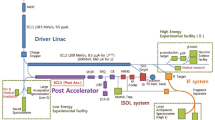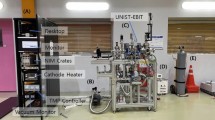Abstract
There is a strong need to push forward developments in the storage and control of ultra-low-energy antiproton beams to enable important scientific research. To this end, a small electrostatic ring, and associated electrostatic acceleration section, is being designed and developed by the QUASAR group. The ring will be placed on the MUSASHI beamline at the CERN-AD. It will serve as a prototype for the future ultra-low energy storage ring (USR), to be integrated at the facility for low-energy antiproton and ion research (FLAIR) and will enable various components of the USR to be tested and optimised. A reaction microscope will be integrated in the ring to enable partial ionisation cross section measurements to be made. This small recycler ring will be unique due to its combination of size, electrostatic nature and energy and type of circulating particles (ca 3–30 keV antiprotons). A short electrostatic accelerating section is also being developed, which will be placed between the beamline and the ring to accelerate the antiprotons from the trap extraction energy (typically 250 eV) to the final required (re-circulating) energy. The AD recycler project will be described, including ring design, accelerating injection section and the inclusion of a reaction microscope and the experiments it will enable.
Similar content being viewed by others
References
Baird, S., et al.: The antiproton decelerator: AD. Proc. Part. Acc. Conf. (1997)
Welsch, C.P., et al.: Hyperfine Interact. 172, 71 (2007)
Welsch, C.P., et al.: Nucl. Instrum. Methods A 546, 405 (2005)
Knudsen, H.: J. Phys: Conf Ser. 194, 012040 (2009). 072001 L. H. Andersen
Dörner, R., et al.: Nuclr. Instrum. Methods Phys. Res. B, 124, 225 (1997)
Torii, H.A., et al.: AIP Conf. Proc. 793, 293 (2005)
Knudsen, H., et al.: Phys. Rev. Lett. 101, 043201 (2008)
Harasimowicz, J.: Hyperfine Interact. 194, 177 (2009)
Putignano, M.: Hyperfine Interact. 194, 189 (2009)
Hvelplund, P., et al.: J. Phys. B 27, 925 (1994)
Andersen, L.H., et al.: Phys. Rev. A 41, 6536 (1990)
Igarashi, A., et al.: Nucl. Instrum. Methods Phys. Res., Sect. B 214, 135 (2004)
Keim, M., et al.: Phys. Rev. A 67, 062711 (2003)
Schultz, D.R., et al.: Phys. Rev. A 67, 022712 (2003)
Kirchner, T., et al.: J. Phys. B. 35, 925 (2002)
Lee, T.G., et al.: Phys. Rev. A. 61, 062713 (2000)
Bent, G., et al.: J. Chem. Phys. 108, 1459 (1998)
McGovern, M., et al.: Phys. Rev. A. 81, 032708 (2010)
Author information
Authors and Affiliations
Corresponding author
Rights and permissions
About this article
Cite this article
Siggel-King, M.R.F., Papash, A., Knudsen, H. et al. Electrostatic ultra-low-energy antiproton recycling ring. Hyperfine Interact 199, 311–319 (2011). https://doi.org/10.1007/s10751-011-0326-4
Published:
Issue Date:
DOI: https://doi.org/10.1007/s10751-011-0326-4




